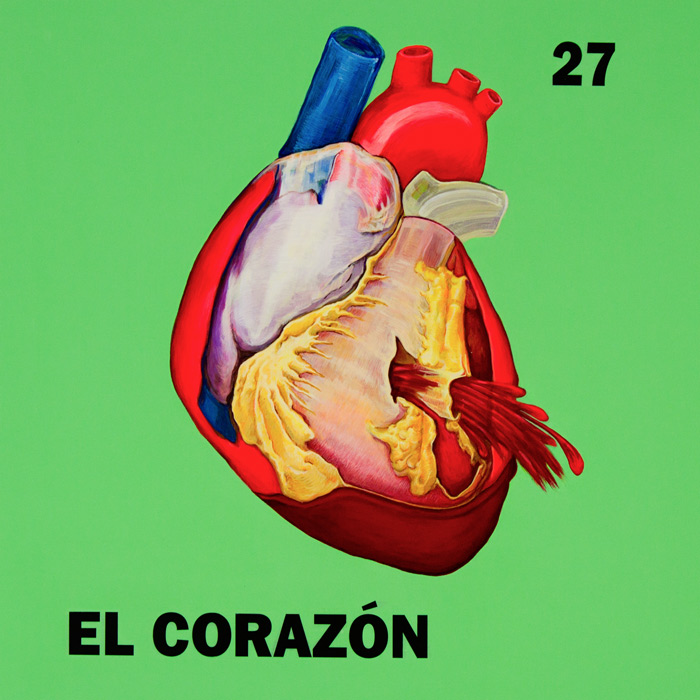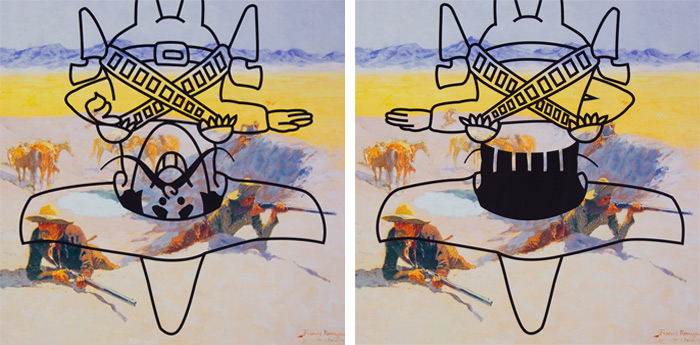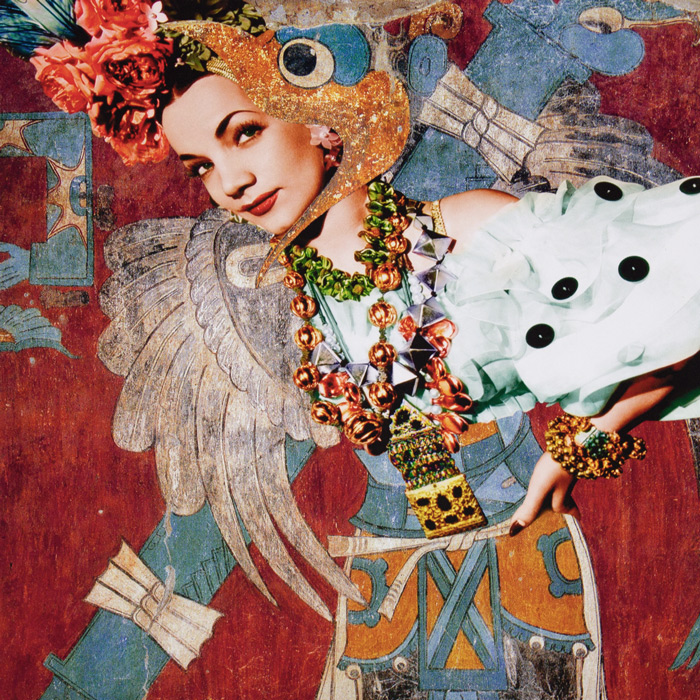Feature image by Bibiana Suarez, Carmen mesoamericana no. 2 / Mesoamerican Carmen no. 2, archival inkjet print
Bibiana Suarez wants you! She wants you to play her game. She wants you to engage in an enthralling experience of Latino history here in the United States of America. “The announcement in 2000 that Latinos had become the largest minority in the United States is what sparked my interest in this particular installation…early in my trajectory as an artist, I saw that people were not truly engaging in my work because of the political content. Early on, I saw that I needed a strategy to disarm viewers of their apprehension.”
Bibiana Suarez’s Memoria (Memory) has been six years in the making. It is absolutely,100% worth the wait. Bibiana’s choice to use the “aesthetics of the game” of Memory is nothing short of brilliant in every aspect, evoking earthly emotion from the images behind each card in the game, utilizing a matching game with (somewhat) open-for-interpretation images for players to debate over and come to an understanding together through the process showcasing her resplendence and courage as an artist. Prepare to have your mind’s eye stimulated while taking in this exhibit and participating in this game. In discussing her process for developing such a magnificent exhibit, the visually stunning game sprawled along the walls of the HPAC becomes much much more.
“How could I use the rules of the game as metaphors and how can I use the rules to point to certain questions. In this game, you have to find pairs. There are very few pairs that are exactly identical. Some of the pairs are close to identical. Some are very different from each other, and that poses a question why they’re not. Then, they’re in dialogue with each other, right? That’s what I mean by the aesthetic of the game.”
In talking with the amazing artist, the world seems clear. The world becomes less black and white and brown and more “of a visual interest.”
“The game is sort of a way that I lure you into a conversation that is very serious.”
The conversation is exactly what the world needs to have on a grand stage as it pertains to its treatment of the people populating it. Why are some humans treated differently than others? Why are some humans looked at differently than others? Why are perceptions twisted and connotations compounded with conjured up incomplete reasoning? So many questions to be answered, but it all comes down to what history decides to remember.
Issues of Latino history, politics, and cultural identity here in the United States are tackled with a universally unique angle. We’ve all played the game of Memory, or some version as kids. “Their familiarity with the game, the structure of the game, will help them see how I am utilizing the game.” Personally, I think this installation has the ability and potential to speak for humans as a whole. Bibiana did not initially see it this way, but appreciates that I do now. “I’ve created a quiet space for reflection on issues that are affecting all of us, but we’re focusing on images that directly affect the Latino community, immigration issues that affect many other immigrant communities and has throughout the history of this country. The dialogue on race and ethnicity affects all of us.”

Corazón herido / Wounded Heart, acrylic paint, laser transfer
Images of pop culture, strong political and social phrases, and recognizable images create an opportunity for us to have the conversation about the broader issue of acceptance and welcome, and the fact that her exhibit provides that platform “pleases (Bibiana) tremendously.”
“I wanted to make the dialogue accessible to all kinds of viewers.” That’s the only way we provide an avenue for progress. “I hope to build all these layers so that the work is very democratic that way.”
That’s a beautiful thing.
But how does one choose the images to create both democracy and a dialogue about our dazzling differences through a game?
“I’ve become quite methodical in my research for projects. I joke that I am a closet sociologist. A cultural anthropologist. I read alot. I write. I look for images that I can manipulate. I go through archives.”
She addresses the Bracero program, migrant workers’ camps, Speedy Gonzalez, marketing to Latinos, Carmen, the exoticism of Latino culture, Frito Bandito (yes, she sang me the song), immigrants…
“Whether the immigrant is legal or illegal, people forget what that person has been through. When you start putting a name and a face to an issue, I’m hoping that will make people reconsider what they’re talking about.”
The exhibit began taking form in 2005, and we were under different leadership then. We were a different country than we are today. Or were we?
In Plastic Patriotism Leads to Salvation, Bibiana finds a plastic bouquet at Joanne Fabric that has been marketed as a patriotic bouquet.

El patriotismo de plástico lleva a la salvación / Plastic Patriotism Leads to Salvation, acrylic paint, collage
“If patriotism is something you can buy for $1.99, something you can have from plastic flowers, it didn’t make sense to me. I painted it over the gold panel at a time when Bush was instituting the Patriot Act, so that was a very big conversation at the moment: How do we measure patriotism? How are we keeping America safe? Who are we keeping safe? Who are we keeping out? I made it gold to look like gold leaf, a reference to the type of religious imagery of the early Renaissance. The passion over patriotic American was talked about as something sacred. All the value that was being talked about. Then it’s recorded in this image of these plastic flowers. And then it’s marketed for $1.99.”
Gold.
“Who is allowed to become an American? Who is part of this country and who is kept away from it?”
Without hesitation, we are led to the next piece from Memoria, Ai Pledch Aliyens, a piece with an ambiguous accent that includes “a desire to belong or a desire to have the contributions you are making to this country recognized.” Whether we acknowledge it or not, we all have a yearning to be recognized for what we do. The fact that American mainstream media picks and chooses what to acknowledge is nothing short of a travesty.
What does the American accent actually sound like? Americans are Europeans, Mexicans, Africans, Asians, Texans, East Coasters, West Coasters. Southerners, Minnesotans, eh? This is supposed to be the great melting pot where anyone can come and prosper in their pursuit of happiness. Am I wrong?
Why Memory and not another game?
“It’s implicated in this conversation: how quickly do we forget? People who have come up the ladder and forgotten that their ancestors were in the same condition. Cultural amnesia…there was a time when we thought that it was great to have immigrants here!”

Frito Bandito en el hoyo de agua no. 1 / Frito Bandito at The Water Hole no. 1, archival inkjet print
Frito Bandito en el hoyo de agua no. 2 / Frito Bandito at The Water Hole no. 2, archival inkjet print

Corazón herido / Wounded Heart, acrylic paint, laser transfer
Beyond the walls of the Hyde Park Art Center exist a litany of social challenges us as humans face if we are to realize our potential and get to where we need to go. Bibiana’s brilliant use of images guide us in the right direction.
“The images are not innocent bystanders. We don’t have enough positive images.”
Why don’t you get involved and hop into the conversation? Hyde Park Art Center hosts two more opportunities for you to get involved with this wonderful exhibit:
Saturday, February 11, 1-3pm
Play, Concentrate, Remember: The Interwoven Histories of Latinos and Mainstream USA
Join Delia Cosentino, Juana Goergen, Gilberto Cardenas, Arlene Davila, and Maria de los Angeles Torres among the participants in this in depth discussion on the themes and issues brought forth by Bibiana Suarez’s current show.
Sunday, March 11, 5:30-7:30pm
Conversation with the artist
Suarez gives you a talk about her exhibit and the work in the gallery. Get to one of these. Seriously.
Both events take place at the Hyde Park Art Center, where the exhibit runs through March 25, 2012.
Hyde Park Art Center | 5020 South Cornell, Chicago, IL 60615 www.hydeparkart.org
Glad to see this in H.P. MUCH needed.